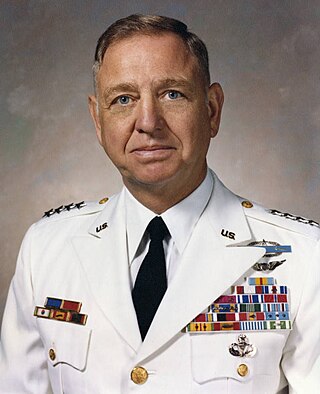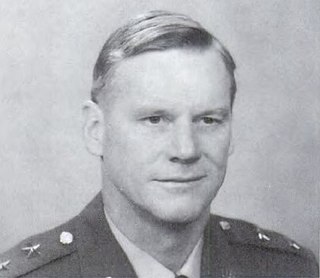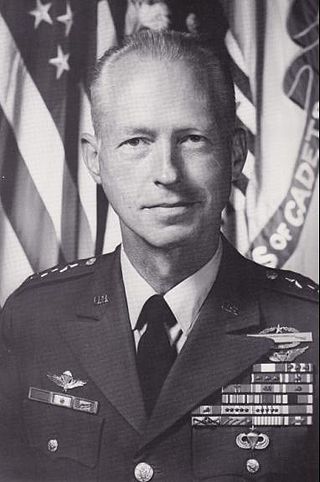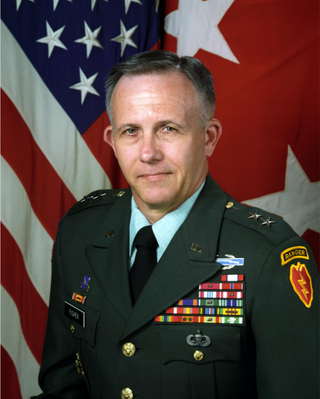
William E. Potts was an American military general.

Lieutenant General William James Lennox Jr. of Houston, Texas, was the 56th Superintendent of the United States Military Academy at West Point, New York from 2001 to 2006.

Lieutenant General Michael David Maples, USA served as the 16th Director of the Defense Intelligence Agency (DIA), appointed on November 4, 2005. He was promoted to lieutenant general on November 29. Maples also commanded the Joint Functional Component Command for Intelligence, Surveillance and Reconnaissance (JFCC-ISR) for the United States Strategic Command (USSTRATCOM). He transferred his Directorship of the Defense Intelligence Agency and his command of JFCC-ISR to LTG Ronald Burgess on March 18, 2009. Maples formally served as the vice director of management of the Joint Staff.

Lieutenant General Franklin Lee Hagenbeck is a retired United States Army officer who served as the 57th Superintendent of the United States Military Academy from June 2006 to July 2010. Previous to his assignment at West Point, he was the Deputy Chief of Staff, G-1 United States Army, Washington, D.C.

Willard Warren Scott Jr. was a lieutenant general in the United States Army. He graduated from the United States Military Academy at West Point in 1948. He was commissioned upon his graduation from West Point and assigned to the artillery. He later went on to serve as superintendent of the United States Military Academy from 1981 through 1986.

Lieutenant General Albert Patton Clark was the sixth superintendent of the United States Air Force Academy near Colorado Springs, Colorado.

Earle Everard "Pat" Partridge was a four-star general in the United States Air Force and a Command Pilot.

General William Allen Knowlton was a United States Army four-star general, and a former Superintendent of the United States Military Academy. As a full general, he served as Commander, Allied Land Forces South East Europe, and as the United States Military Representative to the North Atlantic Treaty Organization.

Michael Shannon Davison was a United States Army four-star general, who served as Commander in Chief, United States Army Europe/Commander, Central Army Group from 1971 to 1975.

Sam Sims Walker was a United States Army general who served as the Commanding General of Allied Land Forces, South East Europe from 1977 to 1978.

Major General Frank Butner Clay was a United States Army officer. He was the son of General Lucius D. Clay Sr. and the brother of General Lucius D. Clay Jr. He is buried at Arlington National Cemetery along with his first wife, Patricia Adams Casey Clay. Patricia Clay was the sister of Major Hugh Boyd Casey, who was killed in an airplane crash while serving as an aide-de-camp to the 3d Infantry Division Commander during the Korean War. They were, in turn, the children of Major General Hugh John Casey of the Army Corps of Engineers, who was the West Point roommate and good friend of General Lucius D. Clay Sr.

Sidney Bryan Berry was a United States Army Lieutenant General, Superintendent of West Point (1974–1977), and Commissioner of Public Safety for the state of Mississippi (1980–1984).

Walter Francis Ulmer Jr. is a retired lieutenant general in the United States Army.

Colonel John Leonard Hines Jr. was an officer in the United States Army and the son of General John L. Hines.

James Bradshaw Adamson was a major general in the United States Army.

Major General Thomas E. Ayres is a retired American military lawyer who served as the 20th Deputy Judge Advocate General of the United States Army.

William Peirce Ennis Jr. was a career officer in the United States Army who served as commandant of the Army War College and rose to the rank of lieutenant general.

George A. Fisher Jr. is a retired United States Army officer. He attained the rank of lieutenant general during his career, and is a veteran of Operation Powerpack, the United States action in the Dominican Republic and the Vietnam War. Among his senior command assignments were the Joint Readiness Training Center (1991–1993), 25th Infantry Division (1993–1995), Multi-National Force – Haiti (1995), and First United States Army (1997–1999).

Edward C. Peter II was a career officer in the United States Army. A veteran of the Korean War and Vietnam War, he attained the rank of lieutenant general and was most notable for his command of 2nd Battalion, 27th Infantry, the 1st Infantry Division Support Command, the Department of the Army Legislative Liaison Office, the 5th Infantry Division and Fort Polk, and Fourth United States Army. Peter received the Combat Infantryman Badge twice, and his awards and decorations included the Army Distinguished Service Medal (2), Silver Star (2), Legion of Merit (2), Bronze Star Medal (2), Meritorious Service Medal, Air Medal (6), and Army Commendation Medal.

Robert H. York was a career officer in the United States Army. A 1938 graduate of the United States Military Academy, he attained the rank of lieutenant general, and was a veteran of World War II, Allied-occupied Germany, the Malayan Emergency, the Vietnam War, and Operation Power Pack, the 1965 U.S. intervention in the Dominican Republic during its civil war. His command assignments included the 331st Infantry Regiment, director of the Tactical Department and director of instruction at the United States Army Infantry School, director of the International Division in the army's Office of the Chief of Research and Development, director of Defense Research and Engineering for the United States Department of Defense, director of the Defense Advanced Research Projects Agency's Research and Development Field Unit and Joint Operations Evaluation Group in South Vietnam, the 82nd Airborne Division, the Infantry School, and XVIII Airborne Corps.




















